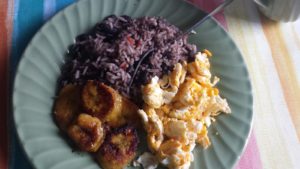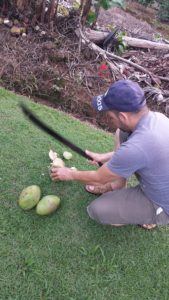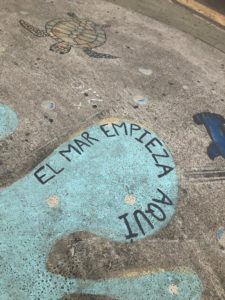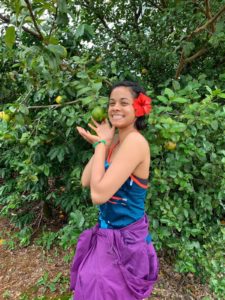 This blog post was written by Aliya during her 4th year in the Environmental Management stream.
This blog post was written by Aliya during her 4th year in the Environmental Management stream.
A big part of travelling is discovering what it’s like to live in the country you’re visiting. If you have read any of my other blog posts about the Semester Abroad program, then you will know I always mention Costa Rican food and the Tico (This means a person from Costa Rica) culture which is a big part of the experience. The way they do things in Costa Rica often differs from life back in Canada. If you’re interested in doing the Semester Abroad program, here are some things to expect:
Beans and Rice: The Staple of Any Meal

Beans and rice, cooked plantain and scrambled eggs
There is a wide variety of dishes in Costa Rica. While I can’t speak on behalf of all the food that is served there, I can definitely talk about the food that was served to me while living at various homestays. The most staple of any meal in Costa Rica, be it breakfast, lunch, or dinner, is black beans and white or brown rice. Throughout the day, I had beans and rice at least once with every meal. Unlike in Canada, I also discovered that families in Costa Rica eat meat sparingly. I would usually eat meat once a week (fish, chicken or beef) but in small quantities: The serving of meat never took up more than a quarter of my plate.
Fresh Food is Key

Aliya eating her lunch from a banana leaf
Breakfast usually consisted of beans, rice, fried plantain, eggs, empanadas, fresh fruit juice, sugar cane tea or some combination of these. We usually ate lunch at the EcoCampus, which was usually composed of beans, rice, fried plantain, chicken or beef, fresh cut fruit, salad, soup and fruit juice. I loved having fresh fruit and fresh fruit juice every day. The first homestay family I stayed at had so many mango trees and so many mangoes they couldn’t even eat them all! So, my homestay mom just made into juice, so she didn’t have to waste the mangoes and we could still enjoy them.
Dinner Time is Family Time

My homestay Dad cutting open coconuts!
Dinner was my favourite time of day because I got to sit down with my homestay families to get to know them and work on speaking Spanish. At both of my homestays, dinner was usually served an hour after we got home from school at around 5 or 6 pm. We would usually eat beans, rice, chicken or bean stew, baked or fried fish, vegetable soup, empanadas, salad (lettuce, tomato, cucumber, lemon juice), mashed cassava and sometimes have fresh fruit with jello for dessert. Dinner was generally sit down and bowls of food was passed around the table to encourage discussion and bring everyone together. This was my favourite part of the day because not only did I get to eat delicious food, but it also allowed me to become closer with my homestay families and made me feel like I was at home with my own family.

Me and my homestay mom!
Also, with the families I stayed with at least, I found that they were very family oriented. Every day, cousins, grandparents and extended family members made their way over to check in on their family whether it was for coffee, dinner or just to say hello. Sometimes even the neighbours would come over for a chat or the kids would all play together in the yard making the atmosphere friendly, loving and safe.
The Importance of the Environment

Environmental mural in downtown San José
Fitting for someone in Environmental Studies, the Tico culture is largely based around being environmentally aware, protecting the environment, and being one with the environment. Many of the locals I spoke with always had input about protecting the environment and places that I could visit to learn about what Costa Rica is doing to conserve the natural environment and the immense biodiversity it is so well known for. When I was sightseeing in San José, there was this mural of a sea turtle on the ground with messages about plastic pollution and its effects on our natural environment. It was cool to see the shared belief in the importance of the environment everywhere I went.
Less is More
Another thing I learned about the Tico culture is that people are happy with only the essentials. With the families and locals I came across, I didn’t notice people driving huge, expensive cars or buying things in bulk like we do in Canada. Many people go with “a little goes a long way". I never saw people throwing things away unless it went bad and if things didn’t work the way they should, people would try to fix it before throwing it out and buying a new one.
Pura Vida!

Aliya holding a Limon
Lastly, Costa Rica has the highest standard of living of all the Central American countries and is well-known for their laid back and simple lifestyle. The saying “Pura vida”, means life is good, have a good day, be happy and everything is okay. This is said widely among Ticos and is even something that I caught onto saying myself as well. Many people in Costa Rica understand that life is short. You should try being the happiest you can and enjoy all that you can because life is beautiful, and we should not be taking it for granted. Pura Vida!

